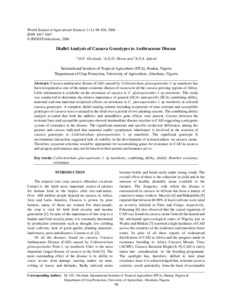| dc.contributor.author | Owolade, F. |
| dc.contributor.author | Dixon, A. |
| dc.contributor.author | Adeoti, A. |
| dc.date.accessioned | 2019-12-04T11:18:06Z |
| dc.date.available | 2019-12-04T11:18:06Z |
| dc.date.issued | 2006 |
| dc.identifier.citation | Owolade, F., Dixon, A. & Adeoti, A. (2006). Diallel analysis of cassava genotypes to anthracnose disease. World Journal of Agricultural Sciences, 2(1), 98-104. |
| dc.identifier.uri | https://hdl.handle.net/20.500.12478/3042 |
| dc.description.abstract | Cassava anthracnose disease (CAD) caused by Colletotrichum gloeosporioides f. sp manihotis has been recognized as one of the major economic disease of cassava in all the cassava growing regions of Africa. Little information is available on the resistance of cassava to C. Gloeosporioides f. Sp manihotis. This study was conducted to determine the relative importance of general (GCA) and specific (SCA) combining ability, maternal and non-maternal reciprocal effects on resistance to C. Gloeosporioides f. sp manihotis in selected cassava genotypes. A complete diallel mating scheme including reciprocals of nine resistant and susceptible genotypes of cassava were evaluated in the field over a period of two planting seasons. The combining ability analysis revealed that both the additive and nonadditive gene effects were present. Crosses between the resistant lines and susceptible genotypes showed intermediate disease reaction to CAD suggesting a polygenic system of resistance to the disease. The significant maternal and specific reciprocal differences among the parents and crosses indicated that maternal and/or cytoplasmic inheritance is involved in the reaction of cassava genotypes to Colletotrichum gloeosporioides f. Sp manihotis. The significant genotype X environment interaction suggested lack of stability in the development of lesions/cankers on cassava stems. Therefore, recurrent selection would be appropriate for accumulating genes for resistance to CAD in cassavaand progeny performance may not be based on their parents performance per se. |
| dc.language.iso | en |
| dc.subject | Collectotichum Gloeosporiodes F. Sp Manihotis |
| dc.subject | Combining Ability |
| dc.subject | Cassava Genotypes |
| dc.subject | Diallel |
| dc.subject | Manihot Esculenta |
| dc.subject | Resisitance |
| dc.subject | Cassava Anthracnose Disease |
| dc.title | Diallel analysis of cassava genotypes to anthracnose disease |
| dc.type | Journal Article |
| dc.description.version | Peer Review |
| cg.contributor.affiliation | International Institute of Tropical Agriculture |
| cg.contributor.affiliation | Federal University of Agriculture, Nigeria |
| cg.coverage.region | Africa |
| cg.coverage.region | West Africa |
| cg.coverage.country | Nigeria |
| cg.authorship.types | CGIAR and developing country institute |
| cg.iitasubject | Farm Management |
| cg.iitasubject | Genetic Improvement |
| cg.iitasubject | Farming Systems |
| cg.iitasubject | Handling, Transport, Storage And Protection Of Agricultural Products |
| cg.iitasubject | Plant Genetic Resources |
| cg.iitasubject | Disease Control |
| cg.iitasubject | Pests Of Plants |
| cg.iitasubject | Plant Breeding |
| cg.iitasubject | Livelihoods |
| cg.iitasubject | Plant Health |
| cg.iitasubject | Plant Production |
| cg.iitasubject | Plant Diseases |
| cg.accessibilitystatus | Limited Access |
| local.dspaceid | 94508 |

